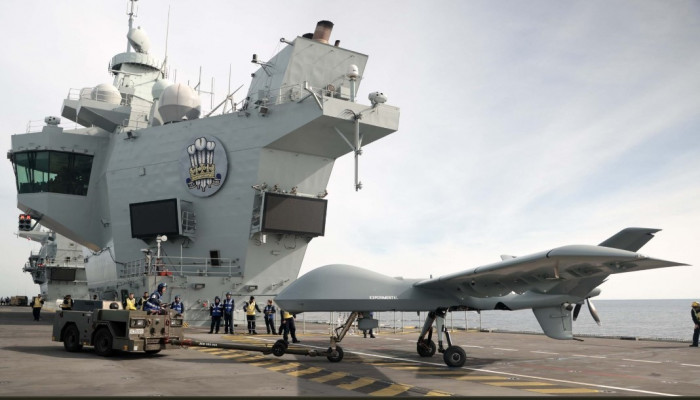UK Royal Navy launches Mojave drone aboard aircraft carrier
- In Reports
- 06:25 PM, Nov 18, 2023
- Myind Staff
The UK naval air power, the Royal Navy has successfully launched and landed the largest uncrewed aircraft ever from the aircraft carrier HMS Prince of Wales. Codenamed 'Mojave,' this specially modified aircraft, boasting a nine-meter length and a wingspan of 17 meters (six meters wider than an F-35B Lightning stealth fighter), weighs over 1½ tonnes when fully loaded.
The Mojave drone boasts impressive dimensions, measuring nine meters in length, with a wingspan of 17 meters—six meters wider than an F-35B lightning stealth fighter—and a weight exceeding 1½ tonnes when fully loaded. Notably, no uncrewed machine of this size has ever taken flight from an aircraft carrier outside the US Navy.
This trial, conducted off the coast of Virginia, marks a milestone for the UK's Queen Elizabeth-class aircraft carriers, showcasing the potential for modern uncrewed air systems to operate seamlessly alongside fifth-generation crewed aircraft like the Lightnings. The successful integration of such advanced technology opens new avenues for the future of UK naval air power.
“The Mojave trial is a European first – the first time that a Remotely Piloted Air System of this size has operated to and from an aircraft carrier outside of the United States,” said Rear Admiral James Parkin, Royal Navy Director Develop, whose team planned the trial.
“The success of this trial heralds a new dawn in how we conduct maritime aviation and is another exciting step in the evolution of the Royal Navy’s carrier strike group into a mixed crewed and uncrewed fighting force.”
The Royal Navy’s Second Sea Lord, Vice Admiral Martin Connell, said embracing autonomy was “the next logical step to ensuring that the Royal Navy can continue to fight and win in an increasingly complex operating environment”.
He continued, “With so many international partners interested in the results of these Mojave trials on board HMS Prince of Wales, I am delighted that we are taking the lead in such exciting and important work to unlock the longer-term potential of the aircraft carrier and push it deep into the 21st Century as a highly-potent striking capability.”
The Royal Navy, with a two-decade track record of operating pilotless aircraft from its ships, has primarily utilized existing systems like the hand-launched Puma and the upcoming Peregrine miniature helicopter for short-range surveillance operations on both land and at sea. The Peregrine is set to enter service in January.
The Mojave is a modified version of the MQ1C Gray Eagle aircraft, designed for short take-off and landing from runways even shorter than those on the flight deck of Queen Elizabeth-class carriers, representing a larger and more intricate aircraft.
Manufactured by General Atomics, Mojave demonstrates the capability for long-endurance missions. The successful trial, involving meticulous planning by experts from the Royal Navy and General Atomics, pushes operational boundaries with crewless aircraft and F-35s, providing insights into the UK's carrier capabilities.
“My team and I are excited and proud to be the first to launch and land a Mojave from an aircraft carrier,” said Commander Martin Russell, in charge of air operations aboard HMS Prince of Wales.
During a deployment centered around experimentation and expanding the envelope of the Queen Elizabeth class, this is one of the highlights.
“Integrating the Navy Develop and General Atomics personnel into the Prince of Wales team was key to enabling such a large Remotely Piloted Air System to operate from the deck during this trial, with the capability feeling like a glimpse into the future of these ships.”
HMS Prince of Wales is currently engaged in rigorous training and trials with the US Marine Corps before its scheduled return to Portsmouth next month.
Image source: Naval News







Comments